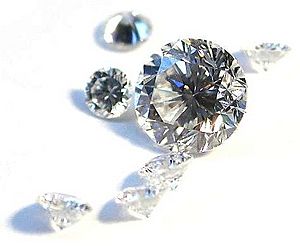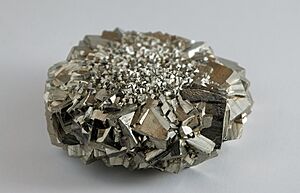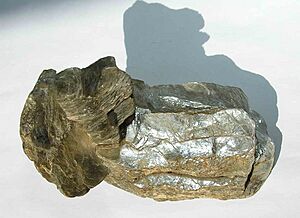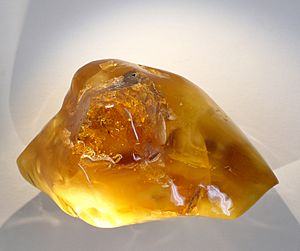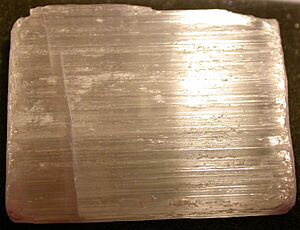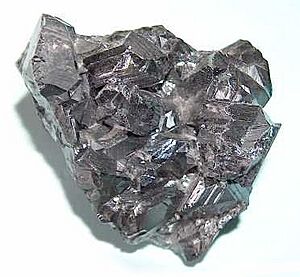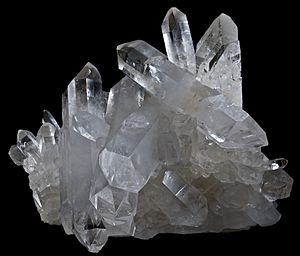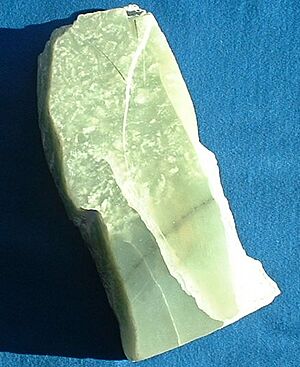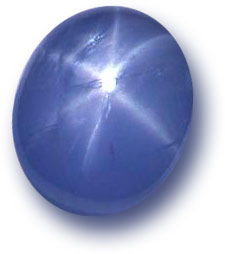Luster (mineralogy) facts for kids
Luster (also spelled lustre) is how light bounces off the surface of a crystal, rock, or mineral. It's like how shiny or dull something looks. For example, a diamond has a super bright shine, while pyrite (also known as "fool's gold") looks like polished metal.
The word "luster" comes from the Latin word lux, which means "light". It generally describes how radiant, glossy, or brilliant something appears.
Contents
Discovering Different Kinds of Luster
What is Adamantine Luster?
Adamantine minerals have a very strong and bright shine. The most famous example is the diamond. These minerals are usually clear or see-through. They also have a high refractive index, meaning light bends a lot when it goes through them.
Minerals with a true adamantine luster are rare. Some examples include cerussite and cubic zirconia. Minerals that are almost as shiny are called subadamantine. Examples of these are garnet and corundum.
What is Dull Luster?
Dull (or earthy) minerals have very little shine. This is because their surfaces are rough and scatter light in many directions. Think of a chalky surface. An example is kaolinite. Sometimes, "dull" and "earthy" are used slightly differently. "Earthy" minerals are often rougher and have even less shine.
What is Greasy Luster?
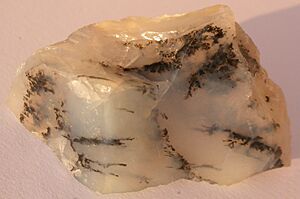
Greasy minerals look like they are covered in fat or grease. This often happens when a mineral has many tiny bits (inclusions) inside it. Examples include opal and cordierite. Many minerals with a greasy luster also feel a bit greasy when you touch them.
What is Metallic Luster?
Metallic minerals look like polished metal. They are very reflective, just like a mirror. Examples include galena, pyrite, and magnetite.
What is Pearly Luster?
Pearly minerals look like pearls. They are made of thin, flat layers that reflect light. This gives them a soft, shimmering look. These minerals can be easily split into thin sheets. Examples include muscovite and stilbite.
What is Resinous Luster?
Resinous minerals look like resin, chewing gum, or smooth plastic. The best example is amber, which is actually fossilized resin.
What is Silky Luster?
Silky minerals have a shine that reminds you of silk. This happens because they are made of many tiny fibers lined up next to each other. Examples include asbestos, ulexite, and the satin spar type of gypsum. A "fibrous" luster is similar but has a rougher texture.
What is Submetallic Luster?
Submetallic minerals look like metal, but they are not as shiny or reflective. This type of luster is often seen in minerals that are almost opaque (you can't see through them) and have a very high refractive index. Examples include sphalerite, cinnabar, and cuprite.
What is Vitreous Luster?
Vitreous minerals look like glass. The word "vitreous" comes from the Latin word for glass, vitrum. This is one of the most common types of luster. It's found in clear or see-through minerals that have a relatively low refractive index. Common examples include calcite, quartz, topaz, beryl, tourmaline, and fluorite.
What is Waxy Luster?
Waxy minerals have a shine that looks like wax. Examples include jade and chalcedony.
Cool Light Effects in Minerals
What is Asterism?
Asterism is when a mineral shows a star-shaped light pattern. You can see this in some sapphires and rubies. It's caused by tiny needle-like impurities inside the stone. It can also appear in garnet, diopside, and spinel.
What is Aventurescence?
Aventurescence is a glittery effect. It happens because of tiny, flat mineral pieces inside the stone. These pieces are so many that they also affect the stone's main color. For example, in aventurine quartz, tiny bits of green fuchsite make the stone green. Different iron oxides can make it red.
What is Chatoyancy?
Chatoyant minerals show bright bands of light that seem to move as you turn the stone. This happens because the minerals have parallel fibers or tiny tubes inside them. These fibers reflect light in a special way, creating narrow bands of light. The most famous examples are tiger's eye and cymophane. This effect can also be seen in other minerals like aquamarine, moonstone, and tourmaline.
What is Color Change?
Color change is a cool effect where a mineral changes color depending on the type of light it's in. It's most common in alexandrite, which is a type of chrysoberyl gemstone. Other gems like sapphire, garnet, and spinel can also show this.
Alexandrite from the Ural Mountains in Russia is green in daylight and red under a regular light bulb. Other alexandrite might be yellowish or pink in daylight and turn a purplish or raspberry red under different light. The best color change is from a bright emerald green to a purplish-red, but this is very rare.
What is Schiller?
Schiller is a German word for "color play." It's a metallic, rainbow-like shine that seems to come from inside the stone. It happens when light reflects between thin layers of minerals. You can see this in moonstone and labradorite. It's very similar to adularescence and aventurescence.
Images for kids
See also
 In Spanish: Lustre para niños
In Spanish: Lustre para niños


